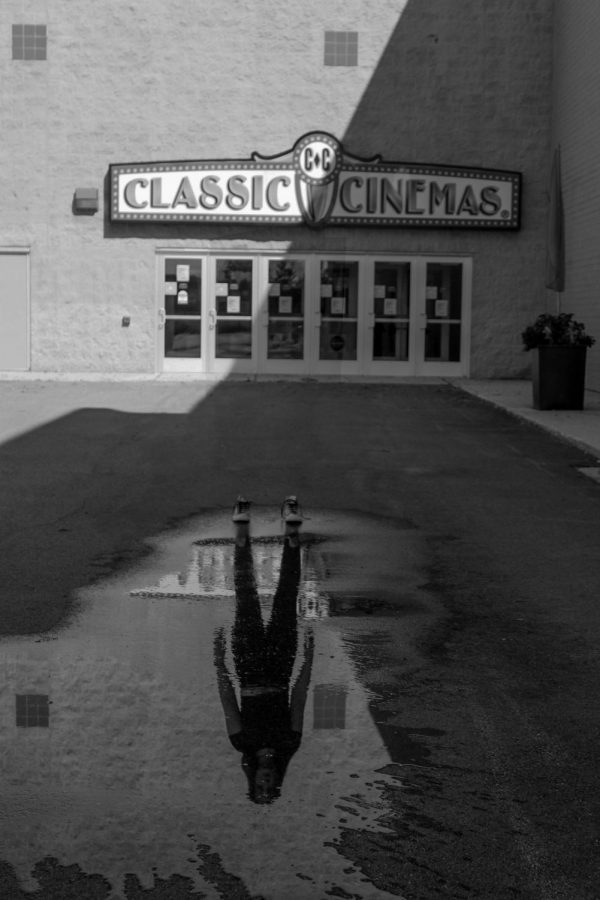Quarantine: Hitting Theaters Near You
Classic Cinemas Charlestowne 18 Theater is one of the many theaters temporarily closed due to COVID.
August 24, 2020
With the crashing economy and quarantine due to COVID-19, many businesses had to close for long periods of time, and not all of them survived the break. Movie theaters have been no exception.
Movie theaters have been on the decline even before the coronavirus. According to the Verge, in 2017, attendance in the US and Canada was at its lowest in 25 years. Their high-priced tickets and concessions were pushed aside in favor of waiting longer for a release on a streaming service. The declining audience meant they would need to further increase their prices to maintain profit, and it became a cycle that they couldn’t escape.
Many small-town theaters were already struggling to stay afloat and were pushed over the edge. The Chicago Mercury Theater is a local example. It had to shut down permanently over quarantine. Even billion-dollar corporations faced this reality. AMC, a leading theater chain, was on the brink of bankruptcy until a last-minute deal with bondholders and Silver Lake private equity firm. They tried to entice customers to come with 15¢ tickets when they opened again on August 20, but this could push them further into debt, ultimately doing more harm than good.
Movie theaters were especially vulnerable for shutdowns because their close seating would require severe profit cuts to follow social distancing. Another challenge was the lack of movies to show. Many blockbusters set to release in the summer and fall were delayed due to the virus. Major movies like “Black Widow,” “A Quiet Place Part II,” “Peter Rabbit 2,” and “Halloween Kills,” are all being pushed back.
Highly anticipated second seasons of two Netflix shows, “The Society” and “I Am Not Okay With This,” were canceled entirely, even though they had already been renewed and scripts were already written.
Our own local Elgin Marcus theater has combated this problem by playing older movies in drive-in styles. They have even had drive-in concerts.
Eileen Sheetz, junior, said, “I would really like to [go to a drive-in] because I’m excited to check that out.” Concessions need to be purchased in advance, but the drive-in style has been increasingly desired, growing in popularity, especially among teenagers.
The biggest problem movie theaters are facing is the growing competition of streaming services like Netflix, Disney+, and Amazon Prime. Movies like “Onward” and “Mulan” are being released on Disney+, and many other movies are being released online earlier. Many people would rather watch from the safety and comfort of their own home, where it is often cheaper too.
Sheetz said, “[Even] if there was no COVID-19, I would still want to stay home,” sharing the viewpoint of many preferring to stay at home and stream rather than go to theaters.
Before, movies would deal with online releases by having a rule that movies could only be released online 70-90 days after first debuting in theater. However, Universal decided to release “Trolls: World Tour” in April through video on-demand before its theatrical release to continue making profits at this time. It brought in unprecedented amounts of income for an online release, so Universal then decided to release all videos online at the same time as in theaters in the future. In late April, AMC decided to ban all Universal movies in their theaters in response, and a big kerfuffle ensued.
AMC and Universal eventually agreed to say that movies could be released online 17 days after first being released in theaters. This drastic shortening of the window has massive implications for the future of movie theaters.
At this point, we can only speculate, but it is clear that on-demand streaming services are growing exponentially and are set to take over the entertainment scene.
Streaming services have been growing in popularity since before the pandemic. Studies show that a majority of young adults don’t have cable, only streaming services. Getting rid of cable, or “cord-cutting” is becoming increasingly common in favor of streaming services. Their popularity comes from the large amount of content available, and the round-the-clock accessibility.
Some services have even made their own original content. Though streaming services are gaining popularity at this time, it’s difficult to start a new one. Not only is licensing very expensive, but creating new content is also difficult during quarantine.
One such example of a new streaming service trying to gain a following is Quibi. With extensive advertising and lots of investors, it was anticipated to be a breakthrough with new content, different video formatting, and short episodes. However, after debuting, users found many issues. Quibi tried to fix them, but it was too late, and they lost a massive amount of subscribers after free trials ended. Sensor Tower, a mobile app data company, estimated as much as 92% didn’t come back after the trials, though the founder of Quibi disputed those claims.
Though Quibi appears to be finding limited success, the hype for it at first shows just how important these platforms are becoming. During quarantine, with many stuck at home, entertainment has become more important than ever, allowing us to pass the time and distract us from the current reality.
In-person viewing isn’t very likely to become entirely obsolete, but it is undeniable that they do need to change something. We are already seeing this with the comeback of drive-in movies. The question isn’t whether the industry will survive, but how it will adapt and evolve to the new market of consumers that is more impatient than ever.




